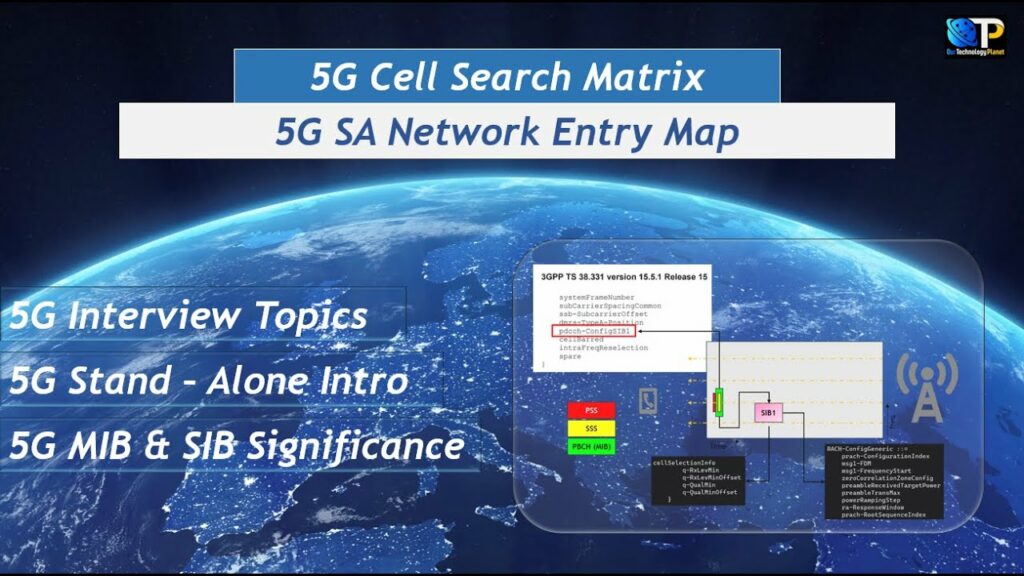In this post, we will discuss 5G SA Cell Search & Network Entry Matrix.
In case of 5G NSA mode, the UE gets all the parameters required for Network Entry from the LTE Anchor. But in case of 5G SA, the UE needs to go through the whole Cell Search process to find the 5G Cell and perform the complete network entry. This session describes the 5G SA Cell Search and Network Entry Matrix in a simplified step by step procedure.
5G SA Cell Search & Network Entry Matrix
In a 5G Standalone (SA) network, cell search is an essential procedure that allows a user device (UE) to synchronize with the base station and establish a connection to the network. The cell search process in 5G SA is similar to other cellular technologies like LTE (Long-Term Evolution) but with some differences due to the new architecture of 5G.
Here is a simplified overview of the 5G SA cell search procedure:
- Synchronization Signal Blocks (SSB): The base station periodically broadcasts Synchronization Signal Blocks. These SSBs contain essential synchronization and system information, helping the UE identify and synchronize with the network. SSBs are transmitted on specific SSB Resource Blocks (SSB-RB).
- SSB Detection: When the UE powers on or enters a new area, it starts searching for the SSBs to identify available 5G cells. The UE scans the available frequency range to detect the presence of SSBs from different base stations.
- Narrowband Synchronization Signal (NSSS) Detection: Once the UE detects an SSB, it searches for the Narrowband Synchronization Signal (NSSS) within the SSB. The NSSS provides more precise timing information for synchronization.
- Frequency and Time Synchronization: The UE uses the NSSS information to synchronize its internal clock and frequency with that of the base station.
- Demodulation Reference Signals (DMRS) Detection: After synchronization, the UE looks for Demodulation Reference Signals (DMRS) in the SSB. DMRS helps the UE estimate the channel characteristics and the cell’s identity.
- Master Information Block (MIB) Decoding: The MIB is part of the SSB and contains essential system information, including the cell identity, system bandwidth, and other configuration parameters. The UE decodes the MIB to acquire this information.
- System Information Block (SIB) Decoding: Once the MIB is successfully decoded, the UE obtains information about higher-layer parameters, such as cell-specific information, neighboring cells, and broadcast scheduling.
- Cell Selection: Based on the decoded information, the UE evaluates various cells’ characteristics and selects the most suitable cell to camp on.
- RRC Connection Establishment: Finally, the UE establishes an RRC (Radio Resource Control) connection with the chosen cell to complete the initial access process and be ready for further communication with the network.
It’s worth noting that the actual 5G SA cell search procedure may involve more complexities and variations based on specific deployment scenarios and network configurations. The process described above is a simplified version to provide a general understanding of the cell search procedure in 5G SA networks.
If this has been helpful, then please also subscribe to our Youtube channel – Our Technology Planet for more exciting stuff and videos.
Ali Khalid
Latest posts by Ali Khalid (see all)
- 5G Coverage Expansion Analysis – Find The Optimal 5G Coverage Threshold For Your Network - November 9, 2024
- 5G Coverage Expansion - November 9, 2024
- 5G SA Cell Search & Network Entry Matrix - July 18, 2023

I have some questions about ensuring LTE network performance at borders is situation same frequencies are shared with other operator
Hello Eshaq,
Thank you for your comment.
Please follow the link below and post your question/feedback in Youtube comments section so that Ali Khalid will be able to answer.
5G SA Cell Search & Network Entry Matrix – https://youtu.be/2YN95HMxeb0